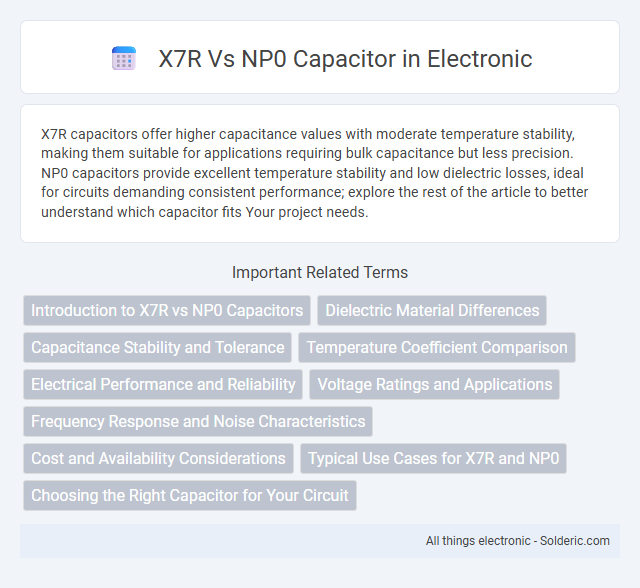X7R capacitors offer higher capacitance values with moderate temperature stability, making them suitable for applications requiring bulk capacitance but less precision. NP0 capacitors provide excellent temperature stability and low dielectric losses, ideal for circuits demanding consistent performance; explore the rest of the article to better understand which capacitor fits Your project needs.
Comparison Table
| Feature | X7R Capacitor | NP0 Capacitor |
|---|---|---|
| Dielectric Type | Class II Ceramic | Class I Ceramic |
| Capacitance Stability | +-15% over temperature | +-30 ppm/degC (very stable) |
| Temperature Range | -55degC to +125degC | -55degC to +125degC |
| Dielectric Constant | High (1250) | Low (23) |
| Loss Tangent (Dissipation Factor) | Higher (0.02 to 0.05) | Very low (0.001) |
| Applications | Decoupling, bypass, general use | High-frequency, RF circuits, timing |
| Cost | Lower | Higher |
| Size | Smaller capacitance per volume | Lower capacitance per volume |
Introduction to X7R vs NP0 Capacitors
X7R and NP0 capacitors differ primarily in their dielectric materials, affecting performance and stability. X7R capacitors offer higher capacitance with moderate temperature stability, making them suitable for general-purpose applications requiring some tolerance to temperature variations. NP0 capacitors provide minimal capacitance change over temperature, ideal for precision circuits where maintaining consistent capacitance is critical for your device's performance.
Dielectric Material Differences
X7R capacitors use a ceramic dielectric material with a composition that allows moderate stability and higher capacitance values, typically defined by a temperature range of -55degC to 125degC with +-15% capacitance variation. NP0 (C0G) capacitors feature a ceramic dielectric with a stable, stoichiometric composition, providing negligible capacitance change over temperature (-55degC to 125degC, +-30 ppm/degC) and excellent low-loss characteristics. Understanding the dielectric material differences between X7R and NP0 capacitors helps you select the right component for applications requiring either higher capacitance or superior stability and precision.
Capacitance Stability and Tolerance
X7R capacitors offer higher capacitance values but have lower capacitance stability, with variations of +-15% over temperature ranging from -55degC to 125degC. NP0 capacitors provide superior capacitance stability and tolerance, typically +-5%, maintaining minimal change across the same temperature range. Choosing NP0 ensures more predictable performance in precision circuits, while X7R suits applications where higher capacitance with moderate stability is acceptable for Your needs.
Temperature Coefficient Comparison
X7R capacitors have a temperature coefficient of +-15% over a -55degC to +125degC range, causing their capacitance to vary significantly with temperature changes. NP0 (C0G) capacitors exhibit a near-zero temperature coefficient, typically +-30 ppm/degC, maintaining stable capacitance between -55degC and +125degC. This superior thermal stability makes NP0 capacitors ideal for precision applications where minimal capacitance drift is critical.
Electrical Performance and Reliability
X7R capacitors offer high capacitance with moderate dielectric stability, making them suitable for general-purpose applications but exhibiting higher temperature and voltage coefficients compared to NP0 capacitors. NP0 capacitors provide superior electrical performance with near-zero temperature coefficient and low dielectric losses, ensuring consistent capacitance and improved reliability in precision circuits. The stability and low aging characteristics of NP0 capacitors result in enhanced long-term reliability under varying environmental conditions.
Voltage Ratings and Applications
X7R capacitors typically offer voltage ratings ranging from 6.3V to 100V, making them suitable for decoupling and filtering in power supply circuits with moderate voltage requirements. NP0 (C0G) capacitors provide stable capacitance and voltage ratings up to 50V, ideal for precision timing and RF applications where temperature and voltage stability are critical. Choosing between X7R and NP0 capacitors depends on your application's voltage demands and the need for capacitance stability under varying electrical conditions.
Frequency Response and Noise Characteristics
X7R capacitors exhibit higher dielectric constant, resulting in greater capacitance but with more variability across frequencies and temperature, which can introduce increased noise characteristics in sensitive circuits. NP0 capacitors maintain stable capacitance and low dissipation factor throughout a wide frequency range, ensuring minimal noise and reliable frequency response for precision applications. Choosing NP0 capacitors can improve Your circuit's signal integrity due to their superior frequency stability and low noise profile compared to X7R types.
Cost and Availability Considerations
X7R capacitors are generally more cost-effective and widely available compared to NP0 capacitors due to their prevalent use in applications requiring moderate stability and high capacitance. NP0 capacitors, offering superior temperature stability and low dielectric loss, tend to have higher production costs and are less commonly stocked, resulting in limited availability. Manufacturers and designers often select X7R for budget-conscious projects while reserving NP0 for precision circuits demanding consistent performance.
Typical Use Cases for X7R and NP0
X7R capacitors are typically used in applications requiring moderate stability and higher capacitance values, such as decoupling, filtering, and bypass circuits in power supplies and analog circuits. NP0 capacitors, known for their superior temperature stability and low dielectric absorption, are preferred for precision timing, RF circuits, and oscillator applications where minimal capacitance variation is critical. The choice between X7R and NP0 depends on the need for capacitance stability versus capacitance density and cost-efficiency.
Choosing the Right Capacitor for Your Circuit
X7R capacitors offer higher capacitance values with moderate temperature stability, making them ideal for decoupling and filtering applications where size and cost efficiency are important. NP0 capacitors provide exceptional temperature stability and low dielectric absorption, suitable for precision timing and high-frequency circuits requiring minimal capacitance variation. Selecting between X7R and NP0 depends on the circuit's performance needs, balancing capacitance stability against cost and physical size constraints.
X7R vs NP0 capacitor Infographic

 solderic.com
solderic.com